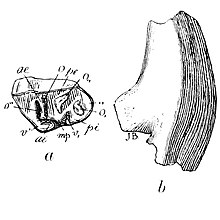|
Argyrohippus
Argyrohippus is an extinct genus of notoungulate, belonging to the family Notohippidae. It lived from the Late Oligocene to the Early Miocene, and its fossilized remains were found in South America. DescriptionThis animal was probably vaguely similar in build and size to a goat. It is mostly known from remains of its dentition, which was very specialized : the dentition was complete and continuous (without diastema), but the premolars and molars were hypsodonts. The canines were small. The premolars had a very developed cingulum, while the molars were quite elongated. The shape of the premolars and molar was very reminiscent of those of Equidae. Its most peculiar distinctive characteristics were the cup-shaped internal cingula and the lack of singula on the premolars, and a thick layer of cementum. ClassificationThe genus Argyrohippus (whose name means "Argentine horse") was first described in 1902 by Florentino Ameghino, based on fossil remains found in Early Miocene deposits in Argentina. The type species is Argyrohippus fraterculus; Ameghino described another species, A. boulei, mainly differentiated from the type species by some dental characteristics, like its more protruding incisors, and by its greater size. In 1935, a new species was described by Bryan Patterson, A. praecox, from the Late Oligocene of Argentina, with more brachydont teeth. Argyrohippus has historically been classified as a member of Notohippidae, a group of notoungulates with teeth similar to those of horses. However, this family is now considered paraphyletic, and several forms included in it may in reality be ancestral to the family Toxodontidae. Argyrohippus may be one of those forms. Bibliography
|
||||||||||||||||||||||||||||||||
Portal di Ensiklopedia Dunia








